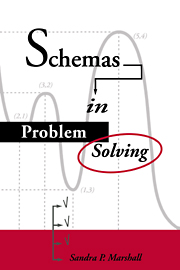Book contents
- Frontmatter
- Contents
- Preface
- Acknowledgments
- I Fundamentals
- II Schemas and instruction
- III Learning from instruction
- 6 Learning and schema theory
- 7 Learning from schema-based instruction
- 8 The acquisition of planning knowledge
- 9 The diagram: Marker and template
- IV Schemas and assessment
- V Schema models
- Notes
- References
- Name index
- Subject index
9 - The diagram: Marker and template
Published online by Cambridge University Press: 22 October 2009
- Frontmatter
- Contents
- Preface
- Acknowledgments
- I Fundamentals
- II Schemas and instruction
- III Learning from instruction
- 6 Learning and schema theory
- 7 Learning from schema-based instruction
- 8 The acquisition of planning knowledge
- 9 The diagram: Marker and template
- IV Schemas and assessment
- V Schema models
- Notes
- References
- Name index
- Subject index
Summary
Over the past 25 years, visual representations have received considerable attention under the various designations of graphics, diagrams, visual aids, or simply pictures. No matter which name is used, the issue is whether their inclusion in instruction makes a significant difference in how and what students learn. The question of their importance extends naturally to schema theory. The most interesting issues have to do with how visual representations fit into the knowledge organization of a schema and what role they have in its access and use.
It is reasonable to expect visual information to be a critical component of schema knowledge. As described in some detail in chapter 1, one of the earliest meanings of σχημα had to do with color, shape, and form. Certainly, the figural representation of a triangle entered into Aristotle's and Kant's conception of it and their elaboration of the triangle schema.
All the available evidence suggests that visual representations should play an important role in schema formation and use. Psychological research has produced a number of notable results about their value in memory storage and retrieval. For instance, pictures are remembered more easily than words (e.g., Pavio, 1975), spatial arrangements of shapes are remembered more accurately than linear orderings of words (e.g., Santa, 1977), visual imagery promotes learning of associations (e.g., Bower, 1972), drawings of problems guide inferences (Anzai, 1991), and visual cues facilitate analogical transfer (e.g., Gick, 1985).
- Type
- Chapter
- Information
- Schemas in Problem Solving , pp. 236 - 264Publisher: Cambridge University PressPrint publication year: 1995



